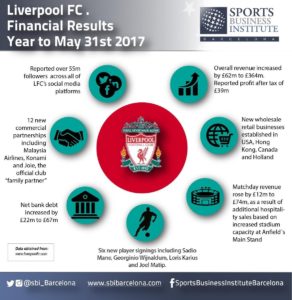Today’s Premier League match between Manchester United and Liverpool FC gives the word ‘competition’ an interesting dimension. The driving force of the modern football economy is the passionate fan identification, which among other things is associated with the fierce rivalry and the obsession linked to today’s match and the strong historic content and legacy of each club. Football is a socio-cultural phenomenon connected with the dynamic negotiations of meaning, which have surrounded this rivalry for decades. To exemplify significance of the historic content and legacy, consider the famous Bill Shankly rhetoric statement that football goes beyond life and death in its expression of importance. Or consider the meaning of the ‘Busby Babes’ and the air plane tragedy in Munich in the 1950s as symbolic value in bringing the label ‘United’ to life. Both examples have helped to shape the fandom associated with both clubs and thus to form the incremental revenue sources in the modern football economy. Now, the consumption of today’s rivalry takes place with astronomic economic impact.
Football and in particular the English Premier League (when focusing on domestic football leagues) have become global marketplaces, in which the historic content as exemplified above and more recent footprints like United’s famous ‘Class of 92’ culminating with the treble in 1999 and Liverpool’s dramatic ‘Miracle’ in Istanbul in 2005 play vital roles. Today’s match does not reach the same importance as the ‘Champions League’ victories of the two clubs. However, it reflects that football and in particular its ‘high-demand’ rivalries are part of the clubs’ branding history. The sports branding histories of the clubs are phenomena in motion, and although today’s rivalry marks an isolated moment in time, it also serves as the way to build momentum in the clubs’ hunt for something bigger (Manchester City has already proved to be too dominant in this year’s Premier League). Top clubs like Manchester United and Liverpool FC will always strive for Champions League trophies while prioritizing the strategic focus to secure a new successful journey on domestic and European soil on the pitch, which is the best guarantee to enhance business performance.
Both clubs are among the strongest brands in football and well-positioned in the global sports business marketplace for what reason today’s rivalry is not only a matter of what happens on the pitch at Old Trafford. It is much more than Mourinho against Klopp or 4-2-3-1 against 4-3-3. It’s a rivalry that has transcended individual players like Best, Cantona, Beckham, Ronaldo, Dalglish, Barnes, Rush, and Gerrard. However, the rivalry keeps these legends alive in the push to articulate the meaning on the respective club brands and to show the greatness of football in the global market positioning. The ability to defend, attack, tackle, score goals, and blend sophisticated tactical abilities with superb technical execution, strong physical appearance and mental toughness are examined in each rivalry under global limelight and in recognition that football is ‘big global business’. As seen below, Sports Business Institute in Barcelona has emphasized some of the essential economic development points of the two clubs, which underscores that today’s rivalry still holds enormous importance among fans while depicting the massive economic growth in football over the years.
Infographics: financial indicators of Liverpool FC and Manchester United (source: Sports Business Institute Barcelona)


COMMENTS
No comments yet.